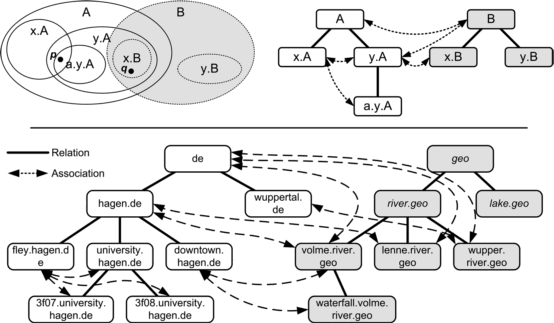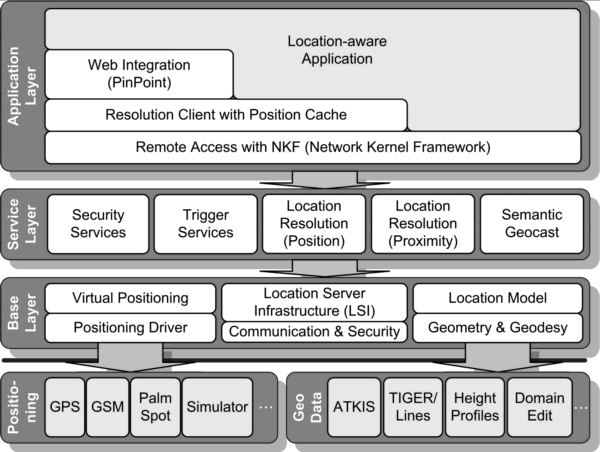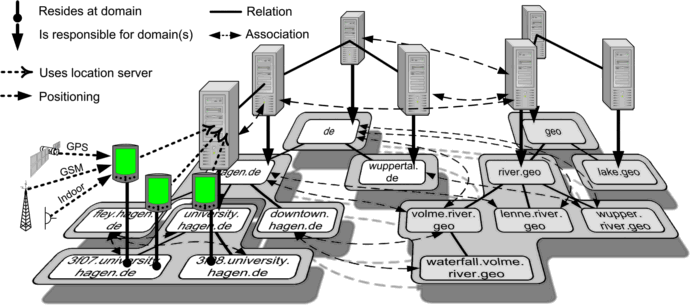| |
A comprehensive project description is provided by this thesis:
| |
Jörg Roth:
A Decentralized Location Service Providing Semantic Locations
Informatik Bericht 323, Habilitation thesis, University of Hagen, Jan. 2005
|
|
In the following, we give a brief overview.
Applications or services which take into account the current location will become increasingly popular in the future. Especially mobile phone providers expect a huge market for such services. Typical applications answer questions like “Where is the nearest hotel?” or “Who of my friends is in proximity?”. Further examples are city guides or navigation systems. Currently, the development of such services is cost-intensive due to the heterogeneity of positioning techniques, positioning systems and location data.
To support developers of location-based services we created the Nimbus framework. Nimbus provides a common interface to location data and hides the position capturing mechanisms. To achieve an optimal flexibility, it provides physical coordinates as well as semantic information about the current location. With Nimbus, mobile users can switch between satellite navigation systems such as GPS, positioning systems based on cell-phone infrastructures, or indoor positioning systems without affecting the location-based service. As our infrastructure is self-organizing, it is flexible and easy to extend.
The concept of semantic locations heavily influenced the Nimbus framework. Semantic locations have a certain meaning for users or applications. Typical examples of such locations are "Campus, University of Hagen" or "City centre of Paris". The key idea of our location model was to strongly couple semantic and physical locations. Having both types of locations has a number of advantages:
- Semantic locations have a meaning to the user and can be used to display information about locations. In addition semantic locations build according to a well-defined name space can easily be used as a search key for traditional databases, tables or lists.
- Physical locations on the other hand are useful for all kinds of geometric queries, e.g. asking for distances between locations, asking for directions.
We assume a tight relation between semantic and physical locations as presented in the next figure. The duality of physical and semantic space is reflected by the Nimbus location model which contains
- a formal specification of sets which describe locations,
- a set of rules that define the relations between these sets,
- a set of operations that process location data, and
- a set of rules to adapt the model according to scalability issues.

The Nimbus location model structures the space and relates physical to semantic locations. It lays the foundation to an efficient infrastructure to store and retrieve location data in a distributed environment. Having only one piece of location information (either physical or semantic), the resolution operations retrieve the corresponding missing information. These operations especially work for a huge amount of location data sets.

The figure above shows the architecture of the Nimbus framework. Using this framework, developers can concentrate on the actual application function and can use location-dependent services of our platform. We distinguish three layers:
The base layer provides basic services related to positioning systems. The framework can use arbitrary positioning systems, ranging from satellite positioning systems, positioning with cell phone networks to indoor positioning systems, based on e.g. infrared or ultrasound. To achieve the required flexibility, we attach the positioning system via a driver interface. This interface allows the framework to switch between positioning systems at runtime. The location model contains a formalism to describe locations and a set of rules to model the world. Finally, the Location Server Infrastructure (LSI) stores the location data and provides services to access these data. It mainly consists of a federation of so-called location servers, each storing a piece of the entire location model (next figure).

The second layer, the service layer, provides higher-level location services. The most important service is the location resolution which allows an application to ask for the current location. In contrast to positioning systems, the location provided by this component contains globally unique physical as well as semantic locations. If more than one positioning system is accessible at a certain location, the framework selects an appropriate system according to the specified parameters. An important service of this layer is the semantic geocast which extends the original idea of geocasting. Trigger services inform the application when a certain location was reached. A set of security functions protect the users and the framework against attacks.
The application layer contains the actual location-aware application or service. A communication middleware called Network Kernel Framework (NKF) was especially designed for small mobile devices such as PDAs or cell phones and offers communication primitives to access the servers. To develop location-aware Web applications we offer a high-level component called PinPoint. The World Wide Web is a powerful platform to develop location-based services, but currently makes no use of the client's current position. PinPoint integrates location information into the HTTP data stream and still allows the usage of existing components such as Web browsers and Web servers without modifications. As an example application, we developed a Web-based tourist guide with PinPoint.
The following list contains papers which are directly related to the Nimbus project. A list of all publications of Jörg Roth can be found here.
Jörg Roth:
Detecting Identifiable Areas in Mobile Environments
The 21st Annual ACM Symposium on Applied Computing, April 23-27, 2006, Dijon, (France), ACM Press, 986-991
|
|
Jörg Roth:
The Distributed Location Resolution Problem and its Efficient Solution
IADIS International Conference Applied Computing 2006, San Sebastian (Spain), Feb. 25-28, 2006, 3-10
|

|
Jörg Roth:
The Role of Semantic Locations for Mobile Information Access
Mobiles Informationsmanagement und seine Anwendungen, Sept. 22, 2005, Bonn, Proceedings of the 35th annual GI conference, Vol. 2, 538-542
|

|
Jörg Roth:
Modelling Location Sensors
2. GI/ITG KuVS Fachgespräch "Ortsbezogene Anwendungen und Dienste", June, 16-17, 2005, Stuttgart, Informatik Bericht 324, University of Hagen, June 2005, 33-36
|
|
Jörg Roth:
A Decentralized Location Service Providing Semantic Locations
Informatik Bericht 323, Habilitation thesis, University of Hagen, Jan. 2005
|

|
Thomas Hadig, Jörg Roth:
Accessing Location and Proximity Information in a Decentralized Environment
International Conference on E-Business und Telecommunication Networks (ICETE 2004), Setúbal (Portugal), Aug. 25-28, 2004, Vol. 1, 88-95
|

|
Jörg Roth:
Novel Architectures for Location-based Services
Annual Meeting for Information Technology & Computer Science, July 7, 2004, Stuttgart, Germany, 5-8
|

|
Jörg Roth:
Eine dezentral organisierte Middleware zur Entwicklung ortsbezogener Dienste
1. GI/ITG KuVS Fachgespräch "Ortsbezogene Anwendungen und Dienste", June 24-25, 2004, Hagen, Informatik Bericht 317, University of Hagen, June 2004, 11-14
|
|
Thomas Hadig, Jörg Roth:
Proximity Services with the Nimbus Framework
IADIS International Conference Applied Computing 2004, Lisbon, Portugal, March 23-26, 2004, IADIS Press, 437-444
|

|
Jörg Roth:
Flexible Positioning for Location-based Services
IADIS International Journal of WWW/Internet, Vol. I, Nr. 2, 18-32
(extended version of the paper for e-Society 2003)
|

|
Jörg Roth:
Accessing Location Data in Mobile Environments - the Nimbus Location Model
Mobile HCI 03 Workshop on Mobile and Ubiquitous Information Access, Udine, Italy, Sept. 8, 2003, LNCS 2954, Springer-Verlag, 256-270
|

|
Jörg Roth:
Semantic Geocast Using a Self-Organizing Infrastructure
Innovative Internet Community Systems (I2CS), Leipzig, Germany, June 19-21, 2003, Springer LNCS 2877, 216-228
|

|
Jörg Roth:
Flexible Positioning for Location-based Services
IADIS International Conference e-Society, Lisbon, Portugal, June 3-6, 2003, Vol. I, IADIS Press, 296-304
|

|
Jörg Roth:
Context-aware Web Applications Using the PinPoint Infrastructure
IADIS International Conference WWW/Internet 2002, Lissabon, Portugal, Nov, 13-15, 2002, IADIS Press, 3-10
|

|
Jörg Roth:
A Communication Middleware for Mobile and Ad-hoc Scenarios
International Conference on Internet Computing (IC'02), June 24-27 2002, Las Vegas (USA), Vol. I, 77-84
|

|
|

 This page
This page 


 email
email